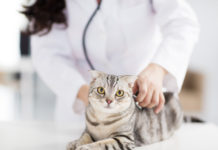Question: Ive been following the recent mad cow disease situation in Washington State and I feel pretty confident that the government has safeguards in place to prevent it from causing any problems. But I have a friend from Great Britain who told me about cats getting sick from eating contaminated food during the mad cow disease crisis over there, and now Im a little worried. Are my cats now at risk of getting mad cow disease?
Answer: Youd have to have been on the spaceship to Mars to miss hearing about mad cow disease – bovine spongiform encephalopathy or BSE – found this past December in a cow in Washington state. The United States Department of Agriculture (USDA) and the Food and Drug Administration (FDA) are working together with state officials in the investigation, and if youd like to stay informed, I suggest you periodically check the USDA website entitled BSE Information and Resources at www.aphis.usda.gov/lpa/issues/bse/bse.html, and an FDA site at www.fda.gov/oc/opacom/hottopics/bse.html. Both contain a wealth of information and are constantly updated. USDA, charged with assuring animal health as well as the safety of certain meat and poultry products, is leading the investigation of this BSE case, whereas FDAs primary responsibility involves animal feed including cattle and cat food.
BSE is the bovine form of a rather mysterious family of contagious brain disorders called transmissible spongiform encephalopathies or TSEs. Recognized hundreds of years ago, it was only recently that transmissible (capable of passing from one individual to another) spongiform (looks like a sponge) encephalopathies (brain diseases) were found to be caused by misshapen proteins called prions. Like the proverbial bad apple spoiling the barrel, prions coerce neighbor proteins in the brain to become malformed, too, and its this accumulation of dysfunctional proteins that causes the disease. (See the article entitled, Prions: Puzzling Infectious Proteins, at the National Institutes of Health site, http://science-education.nih.gov/nihHTML/ose/snapshots/multimedia/ritn/prions/prions1.html)
Prions arent alive in any sense of the word, and theyre resistant to forms of sterilization that inactivate infectious agents like viruses, bacteria and fungi. Prions escape the normal high-temperature rendering process used to transform otherwise inedible tissues into meat-and-bone meal, a common constituent of livestock feed.
The BSE outbreak that peaked in the 1990s in Great Britain is believed to have intensified through feeding cows meat-and-bone meal made, unknowingly, from TSE-infected ruminant tissue. Feeding ruminant source products to cattle has since been banned in Britain, so outbreaks like that shouldnt happen there again.
Similar stringent requirements are in place in the United States: The FDA prohibits the feeding of ruminant-derived proteins to cows, and the USDA restricts importation of live ruminants or ruminant products from countries where BSE has been found. Both agencies are working diligently out of an abundance of caution to prevent prions from entering either ruminant or human food products.
Not Just Cows
It would be bad enough if only ruminants like cattle, sheep and goats were affected, but TSEs occur in many other mammals including cats (dogs, pigs and horses appear to be resistant to infection). A human TSE called variant Creutzfeldt-Jacob Disease (vCJD) is believed to be caused by eating contaminated beef products from BSE-affected cattle. This disease, of course, is the main reason behind all the safeguards; to date, there have been over one hundred confirmed and probable cases of vCJD worldwide among the hundreds of thousands of people that may have consumed BSE-contaminated beef products during the peak of mad cow disease in Europe. The only reported case of vCJD in the United States is in a person who contracted the disease while residing in the UK.
Feline spongiform encephalopathy, or FSE, is the cat form of the disease, and upwards of 100 cases have been reported in Great Britain and Europe, mostly during the BSE peak in the early to mid 1990s. British cats were believed to have gotten the disease by eating BSE-contaminated commercial cat food and butcher scraps, and the number of new cases in domestic cats plunged once measures to prevent BSE materials from entering the food chain were put into place; none has been reported since 1999. No cases in U.S. cats have ever been reported.
Could It Happen Here?
Our growing understanding of TSEs is helping regulatory agencies expand the measures being taken to prevent BSE from ever becoming widespread in cattle here in the States. The regulation of what can or cannot be included in meat products approved for human consumption is an additional line of defense to protect people.
But according to the FDA, products not approved for human consumption, and rendered products prohibited from cattle feed, are allowable for use in pet food.
Nonetheless, such products must originate from countries free of BSE. (The FDA reports that none of the meat from the BSE-infected cow in Washington was released into distribution, so none of it could have wound up in pet food.
Interestingly, some pet food manufacturers use only products approved for human consumption anyway.) As a further level of protection to cats, the FDA disallows importation into the US of any pet foods containing products derived from mammalian sources. So unless BSE were to become prevalent in cattle in the US, the risk of BSE-contaminated pet food is very small indeed.



